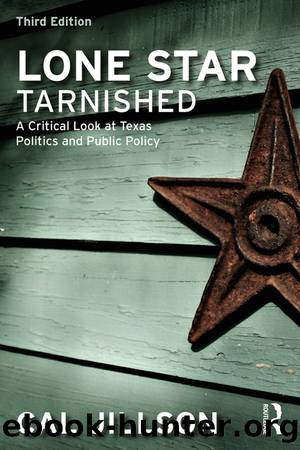Lone Star Tarnished: A Critical Look at Texas Politics and Public Policy by Cal Jillson

Author:Cal Jillson [Jillson, Cal]
Language: eng
Format: epub
Tags: Public Policy, Social Policy, Political Science, Business & Economics, Money & Monetary Policy, General
ISBN: 9781000090574
Google: -MDyDwAAQBAJ
Amazon: B08DJDRSCF
Goodreads: 57443216
Publisher: Routledge
Published: 2020-08-09T00:00:00+00:00
p.137
Figure 6.1 Texas Higher Education Appropriations per FTE as Percentage of Average State Appropriations, 1986â2015
Source: U.S. Census, Statistical Abstract of the United States, âState and Local Financial Support for Post-Secondary Education by State,â 1986â2015, various table numbers, www.census.gov/library/publications/time-series/statistical_abstracts.html.
Nationally comparable figures for higher education funding per FTE student by states became available in 1986 (see Figure 6.1). From 1986 through 2005, Texas state funding for higher education trailed the national average, initially by a lot, later by a little, until Texas broke above the national average in 2006, where it has remained since. Not surprisingly, the price of oil and gas has a great deal to do with the stateâs economic health, state government revenues, and the growth of the PUF. When prices are high, the PUF is growing and state appropriators are confident.30 When prices are low, as they were from early 1986 through 2005, remaining below $40 a barrel for oil, Texas higher education suffers. But in 2005, prices broke above $60 a barrel, peaking in 2008 above $125, and remaining generally above $100 a barrel into mid-2014 when it began to drop like a rock, reaching $28 in early 2016 and ranging between $40 and $50 for the rest of the year.
The importance of PUF and related revenues was highlighted in a study by the LBB for the 2017 legislative session, entitled âFinancing Higher Education in Texas: Legislative Primer.â The study charted the growth of legislative General Fund appropriations and of âOther Funds,â mostly made up of PUF funds, to higher education between 2000â01 and 2016â17. General Revenue funds were $9.3 billion in 2000â01 and $12.2 billion in 2016â17, an increase of 31 percent. Other Funds rose from $2.8 billion in 2000â01 to $8 billion in 2012â13, an increase of 186 percent. Other Funds accounted for 38 percent of higher education funding in 2012â13. But Texasâs supercharged higher education funding slowed markedly with the collapse in the price of oil in the second half of 2014. In 2016â17, the General Fund appropriation remained flat at $12.2 billion, but Other Funds, mostly PUF, fell by 70 percent to $2.3 billion. The decline in PUF funds has just begun to show up in Figure 6.1, but there are good reasons to believe that state funding of higher education will continue to decline at least for the next several years. As the 2017 legislative session pondered cuts to higher education and especially to student financial aid, Texas Commissioner of Higher Education Raymund Paredes called for a reinvention of the stateâs higher education funding levels and formulaes.31
Download
This site does not store any files on its server. We only index and link to content provided by other sites. Please contact the content providers to delete copyright contents if any and email us, we'll remove relevant links or contents immediately.
International Integration of the Brazilian Economy by Elias C. Grivoyannis(74630)
The Radium Girls by Kate Moore(11619)
Turbulence by E. J. Noyes(7700)
Nudge - Improving Decisions about Health, Wealth, and Happiness by Thaler Sunstein(7240)
The Black Swan by Nassim Nicholas Taleb(6762)
Rich Dad Poor Dad by Robert T. Kiyosaki(6174)
Pioneering Portfolio Management by David F. Swensen(6078)
Man-made Catastrophes and Risk Information Concealment by Dmitry Chernov & Didier Sornette(5645)
Zero to One by Peter Thiel(5488)
Secrecy World by Jake Bernstein(4388)
Millionaire: The Philanderer, Gambler, and Duelist Who Invented Modern Finance by Janet Gleeson(4092)
The Age of Surveillance Capitalism by Shoshana Zuboff(3983)
Skin in the Game by Nassim Nicholas Taleb(3965)
The Money Culture by Michael Lewis(3846)
Bullshit Jobs by David Graeber(3826)
Skin in the Game: Hidden Asymmetries in Daily Life by Nassim Nicholas Taleb(3720)
The Dhandho Investor by Mohnish Pabrai(3560)
The Wisdom of Finance by Mihir Desai(3523)
Blockchain Basics by Daniel Drescher(3327)
